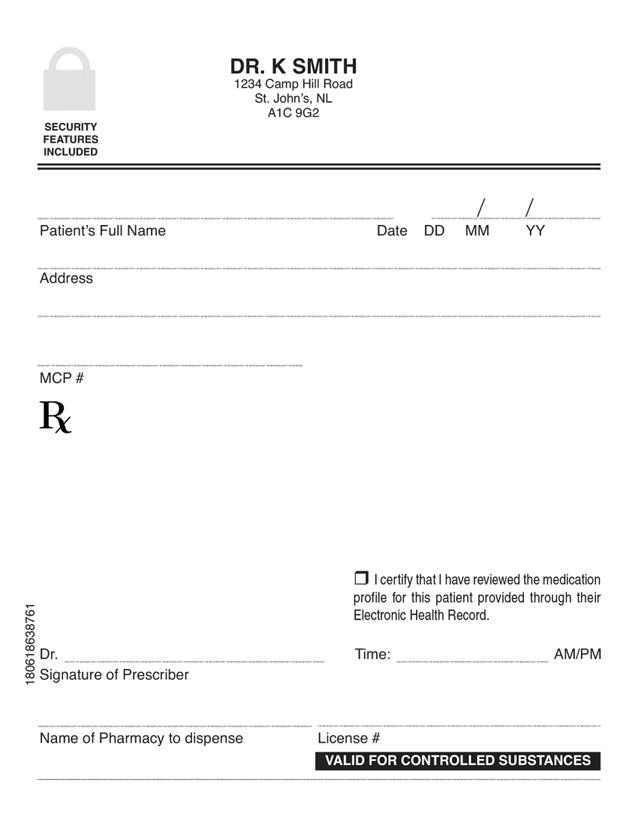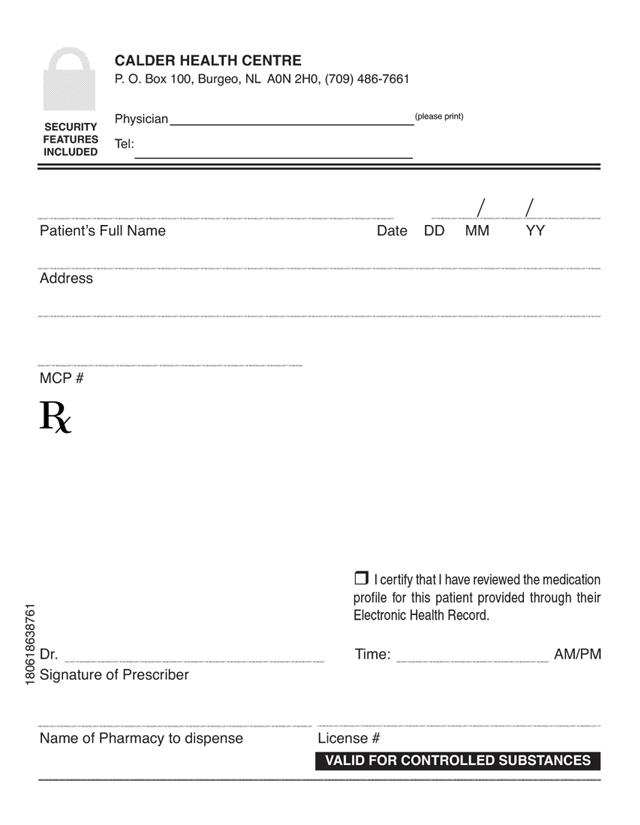- Overview
- Schedule of Drugs
- How the Tamper Resistant Prescription Drug Pad Works
- Prescription Pad Ordering and Security
- Completing a Prescription
- Schedule I – Drugs Required to be Written on Tamper Resistant Pads
- Facsimile Transmission of Prescriptions and Personal Health Information
- Order Forms
Overview
The Department of Health and Community Services, in partnership with the College of Physicians and Surgeons of Newfoundland and Labrador, Newfoundland and Labrador Medical Association, Newfoundland and Labrador Pharmacy Board, Pharmacists’ Association of Newfoundland and Labrador, Newfoundland and Labrador Dental Board, Newfoundland and Labrador Dental Association, Newfoundland and Labrador College of Veterinarians, and the Royal Newfoundland Constabulary, established a tamper resistant prescription drug pad program (TRPP).
The purpose of tamper resistant prescription drug pads is to reduce prescription drug abuse and diversion by reducing the likelihood for prescription forgeries and/or alterations. The tamper resistant prescription pads contain a number of security features that make it difficult to duplicate or alter. These features assist prescribers to fulfill their professional responsibilities by allowing appropriate access to these medications for patients who require them, while being vigilant against some of the factors that facilitate drug abuse and drug diversion.
Under this program, a prescription for a drug listed in the attached Schedule of Drugs would require the use of a tamper resistant drug pad, unless it is a prescription transfer or verbal prescription. In May 2023, amendments were made to the PHARMACEUTICAL SERVICES ACT , to allow for prescription transfers and verbal prescribing in accordance with the Health Canada Controlled Drugs and Substances Act, Subsection 56(1) Class Exemption. For the duration of this exemption, expected until September 30, 2026, the use of the TRPP is not required for prescription transfers or verbal prescriptions.
Faxed prescriptions require the use of the tamper resistant prescription drug pad, unless it is a prescription transfer (See section below Facsimile Transmission of Prescriptions and Personal Health Information).
It is important to note that the tamper resistant drug pad program is NOT a monitoring program. It is in response to the issue of prescription drug abuse and concerns regarding the diversion of certain prescription drugs, some of which is the result of prescription forgeries and alterations.
Schedule of Drugs
The Schedule of Drugs provided with this document is complete for the active ingredients of the drugs that require the use of the tamper resistant prescription pad. Due to the fact that drug names vary over time and new drugs are added to the market, this list will be updated periodically to advise prescribers and pharmacists of the additions. Prescribers should note that benzodiazepines are NOT included in this schedule of drugs, and therefore are NOT required to be written on the tamper resistant prescription pads.
How the Tamper Resistant Prescription Drug Pad Works
Participation: Participation of all physicians, dentists, veterinarians and nurse practitioners is mandatory in order to prescribe drugs listed in the attached Schedule of Drugs. This Program was in consultation with and endorsed by the College of Physicians and Surgeons of Newfoundland and Labrador, the Newfoundland and Labrador Dental Board, the Newfoundland and Labrador College of Veterinarians and the Association of Registered Nurses of Newfoundland and Labrador. Prescription of drugs listed in the Schedule of Drugs must be completed according to the guidelines contained in this document. This also applies to prescriptions that are faxed to pharmacies.
A prescription for a drug listed in the attached Schedule of Drugs would require the use of a tamper resistant drug pad, unless it is a prescription transfer or verbal prescription. In May 2023, amendments were made to the PHARMACEUTICAL SERVICES ACT , to allow for prescription transfers and verbal prescribing in accordance with Health Canada’s Controlled Drugs and Substances Act, Subsection 56(1) Class Exemption. For the duration of this exemption, expected until September 30, 2026, the use of the TRPP is not required for prescription transfers or verbal prescriptions.
Schedule of Drugs: All drugs specified in the attached Schedule of Drugs are included in the Tamper Resistant Drug Pad Program.
Prescription Pad Ordering and Security
Personalized Prescription Pad Ordering: With few exceptions, pads containing 50 prescriptions can be obtained in quantities noted below to healthcare providers within the province of Newfoundland and Labrador:
Practicing physicians – a maximum reorder quantity at any one time of ten (10),
Dentists – a maximum reorder quantity at any one time of ten (10),
Veterinarians – a maximum reorder quantity at any one time of ten (10),
Nurse practitioners – a maximum reorder quantity at any one time of ten (10) pads.
Supplies of prescription pads can be ordered from the Department of Health and Community Services by sending an order form (appended) by fax or mail to the Pharmaceutical Services Division, Department of Health and Community Services.
New Registrants and Locum tenens: New registrants and Locum tenens can order an initial supply of generic prescription pads, using the tamper resistant features that they will be required to use. These tamper resistant prescription pads do not have to be monogrammed and the new registrants and locum tenens can fill in this information.
Hospital Prescription Pads: Supplies of pads have been printed with the names and addresses of hospitals and clinics on them. Arrangements have been made with the Medical Directors of Emergency Rooms (for larger centers) and Hospital Medical Directors (where the former do not exist), for distribution, storage, and re-ordering of these pads. These pads will be supplied to hospitals for use in their Emergency Rooms and other areas as deemed appropriate by the Medical Directors, or their designates.
Security: Tamper resistant prescription pads should be kept in a secure location, preferably under lock and key.
Transfer of Personalized prescription pads: Personalized prescription pads CANNOT be transferred between prescribers.
Loss or theft: Loss or theft of the tamper resistant prescription pad MUST be reported immediately to:
- The Newfoundland and Labrador Pharmacy Board (NLPB)
709-753-5877, or toll free at 1-877-453-5877
AND - The Pharmaceutical Services Division, Department of Health and Community Services,
709-729-6507, or toll free at 1-888-222-0533. - Prescribers should also notify the local police:
Royal Newfoundland Constabulary 709-729-8000
Royal Canadian Mounted Police 1-800-709-7267
Fraud: Prescriptions presented that are suspected of being fraudulent should be reported to the local police at 729-8000 (Royal Newfoundland Constabulary) or 1-800-709-7267 (Royal Canadian Mounted Police).
Destruction/return of the tamper resistant prescription pad: The prescriber is responsible for returning, via a secure method (signature required), any extra copies of the tamper resistant prescription pads to the Department of Health and Community Services, at the following address:
Pharmaceutical Services Division
Department of Health and Community Services
Third Floor, Confederation Building, West Block, 100 Prince Philip Drive
St. John’s, NL A1B 4J6
Tel: 709-729-6507
Completing a Prescription
Use of Prescription Pad: Prescriptions require the use of the approved prescription pad, even when faxed to pharmacies, unless it is a prescription transfer or verbal prescription. Faxed prescriptions must be in accordance with the Newfoundland and Labrador Pharmacy Board (NLPB) Standards of Practice – Facsimile Transmission of Prescriptions and Personal Health Information.
In May 2023,amendments were made to the PHARMACEUTICAL SERVICES ACT , to allow for prescription transfers and verbal prescribing in accordance with the Health Canada Controlled Drugs and Substances Act, Subsection 56(1), Class Exemption. For the duration of this exemption, expected until September 30, 2026, the use of the TRPP is not required for prescription transfers or verbal prescriptions.
Quantities, Duration and Dosage: Quantities and dosage must be entered in both alpha and numerical format. (e.g. 40 and forty). This is considered best practice for all written prescriptions as a safeguard against tampering. Indication of the duration (e.g. 30 (thirty) days supply) is an acceptable alternative to alpha numeric number of units/quantity in writing a prescription for a drug in the attached schedule.
Medical Care Plan (MCP) Number: Include the patient’s MCP number on all prescriptions (with the exception of veterinary patients). For out of province patients, use their provincial health insurance plan number. For members of the Canadian Forces and the RCMP, use their service number or regimental number. Pharmacists should enter only the MCP number in their computer files.
Physicians Office Supply: The approved prescription form is required for the purchase of narcotics and controlled drugs that are to be used by the prescriber in the normal conduct of his/her practice. The prescriber should complete the prescription in his/her own name and use his/her license number in place of the MCP number. The form should be annotated “For Office Use”. This is in accordance with the requirements outlined by the Health Canada Controlled Drugs and Substances Act.
Refills and Part Refills: Refills are not permitted for narcotic prescriptions. For part fills, the total quantity, the quantity of each fill, and the time interval between fills must be specifically indicated both on the prescription and in the pharmacist’s patient’s files. An example of an appropriately written part fill is as follows:
MS Contin 60mg (sixty mg)
i p.o. Q12h
supply 180 (one hundred and eighty) tablets
in lots of 60 (sixty)
at intervals of 30 (thirty) days
Prescription Pad Security Features: Below you will see a representation of what the Tamper Resistant Pad will look like. The first sample shows a personalized pad, the second sample shows a hospital pad.
Numerous security features are incorporated into the pad, the details of which will be provided to you by the Printer when you receive your initial supply. Most of these features are not visible in the representation provided in these samples.


Instructions for completion of the Tamper Resistant Prescription:
- Provide the patient’s complete name and address.
- Provide the patient’s MCP number (with the exception of prescriptions issued for veterinary patients). For out of province patients, members of the Canadian Forces and the RCMP, enter their provincial health insurance plan number or service number as appropriate. Pharmacist should enter only the MCP number on their computer files.
- Print the drug name, strength as well as dosage and specific instructions for use.
- Enter the quantity and dosage in both written and numerical form.
- Only two drugs may be entered on each prescription form. If writing a prescription for narcotics, other drugs can be included.
- Sign and date using the format: DD/MM/YY.
- Print your license number.
- Approved prescription pads contain a preprinted serial number and prescriber identification (i.e. doctor’s name, address, and phone number).
While not mandatory, indicating the Pharmacy to dispense is recommended. Choice of pharmacy should follow discussion between prescriber and patient. Once chosen, no other pharmacy can dispense without contacting the prescriber (verbal confirmation of pharmacy site is acceptable). At a minimum, written prescriptions for patients with whom prescribers have a contract in place that requires adherence to one pharmacy should have the name of that pharmacy indicated on the prescription.
Schedule I – Drugs Required to be Written on Tamper Resistant Pads
- Schedule of Drugs (14 KB)
Facsimile Transmission of Prescriptions and Personal Health Information
When prescriptions are faxed, the NLPB Standards of Pharmacy Operation – Community Pharmacy must be followed. Prescriptions that are faxed for medications included in Schedule I – Drugs Required to be Written on Tamper Resistant Pads, must be written on a tamper resistant pad, unless it is a prescription transfer.
Adobe® Acrobat® Reader software can be used for viewing PDF documents. Download Acrobat® Reader for free
